|
"On May 6th,
1940, "Time" reported news of an event that shook the world of
archaeology: Frank Hibben , a thirty-year-old scholar with the
University of New Mexico, in Albuquerque, had uncovered a cave in New
Mexico's Sandia Mountains evidence of the oldest human culture in the
New World."---1995,
Douglas Preston, "The Mystery Of Sandia Cave," The New Yorker, p. 66.
"The projectile points from the Sandia deposit (in
Sandia Cave) are its most distinctive
cultural feature. Nineteen whole or broken (Sandia)
points were recovered from this layer. They tend to separate into two
main categories."---1941,
Frank C. Hibben, "Evidences Of Early Occupation In Sandia Cave, New
Mexico, And Other Sites In The Sandia-Manzano Region," Smithsonian
Misc. Collections, Vol. 99, No.23, p. 24.
"----all sites for which claims of
antiquity greater than Clovis are made have come under intensive
scrutiny.---The first and certainly most controversial pre-Clovis
complex in the region (southwest)
is Sandia, defined from Sandia Cave and augmented by work at the open
site of Lucy."---2006,
Bruce B. Huckell and W. James Judge, "Paleo-Indian: Plains And
Southwest," Environment, Origins, And Population, Vol. 3,
Smithsonian Institution, p. 149.
"Although
radiocarbon dates ranging from 33,000 to 15,000 BC were reported for the
Sandia complex, questions arose about the association of the cultural
material and the fossil bone that was used for radiocarbon dating, the
interpretation of the stratigraphic position of the Sandia artifacts
within the cave, and other problems."---1997,
Linda Cordell, "Archaeology Of The Southwest" p. 77.
"Sandia points have
been reported from many areas, but the only other known Sandia site is
the Lucy site, in the Estancia Basin of New Mexico. Unfortunately, the
Lucy site has been subject to aeolian deflation and has produced a mixed
assemblage including Sandia, Clovis, and Folsom points as well as
Archaic artifacts."---1997,
Linda Cordell, "Archaeology Of The Southwest" p. 77.
"The Sandia Cave materials, once candidates for an
earlier position, cannot be credibly interpreted, leaving their true age
unknown."---1978,
Jesse D. Jennings, "Ancient Native Americans," p. 332.

SANDIA
AMERICA'S PILTDOWN?
SANDIA CAVE
DESCRIBED AS EARLY
PALEO INDIAN IN 1941 REPORT
SANDOVAL COUNTY, NEW MEXICO
Sandia Cave is, without a doubt, the most controversial archaeological
site ever excavated in the United States. The Sandia Cave excavation
became immediately famous when, "On May 6, 1940, "Time" reported news of
an event that shook the world of archaeology: Frank Hibben, a
thirty-year-old scholar with the University of New Mexico, in
Albuquerque, had uncovered in a cave in New Mexico's Sandia Mountains
evidence of the oldest human culture in the New World." In the beginning, when the
Smithsonian first published Frank Hibben's report, the site conjured up
images of first Americans and a connection to Europe. But as the years
went by, Sandia has become more of a thorn in the side of the
archaeological community and an embarrassment to the science. Comments about Hibben's
interpretation of the site range from just honest mistakes to fraud.
Sandia will probably never go away completely. Professional and
non-professional publications continue to refer to this famous site. But
in recent years those who do will, more-often-than-not, comment that Sandia has lost its credibility and
let it go at that.
|
|
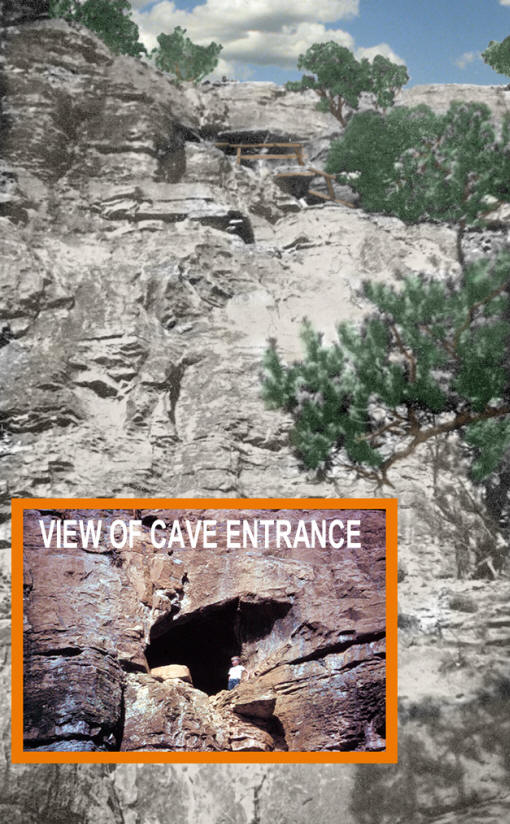
FROM SMITHSONIAN REPORT VOL. 99 NO. 23, INSET PICTURE FROM LITHIC
CASTING LAB COLLECTION
SANDIA CAVE
SANDOVAL COUNTY, NEW MEXICO
These pictures show the entrance to Sandia cave. The opening is situated
high on a limestone bluff. Four other caves are located in the
immediate vicinity of Sandia cave. All of these caves were
excavated. The only evidence of an early occupation was discovered
in Sandia cave. In 1961, Congress declared Sandia Cave a National
Historic Landmark, and a bronze plaque was affixed below it, noting
that the site possessed "national significance in commemorating the
history of the United States of America." |
|
|
It almost seems that in order to understand Sandia you have to
study the man in charge of the excavation, Frank Hibben. The most in
depth investigation of every aspect of the Sandia cave excavation and
the personalities involved was written by Doug Preston in 1995 and
published in "The New Yorker" magazine. This very lengthy article reads
like a good movie script and would in fact make a very good movie. Frank
Hibben was born in Ohio in 1910 and lived 92 years. He wore many hats.
He was very wealthy and evidently had good connections with important
people including at least one president. He was a big game hunter, a
naval officer in World War II as an aide to one of the Joint Chiefs of
Staff in Washington DC and carried shrapnel in his body from a German
submarine that once shot down his plane. He was involved in at least one
covert spying activity for the US government when he traveled to a
foreign country. He was also a tv personality and an archaeologist. Most
people agree that he definitely was a very likable guy with a unique
personality. Preston writes that, "One former student, Dave Snow,
recalled that when Hibben taught hominid evolution he would start the
lecture by "grabbing the doorjamb and swinging into the classroom like
an ape, and leap up on his desk and make ape-like sounds." |
|
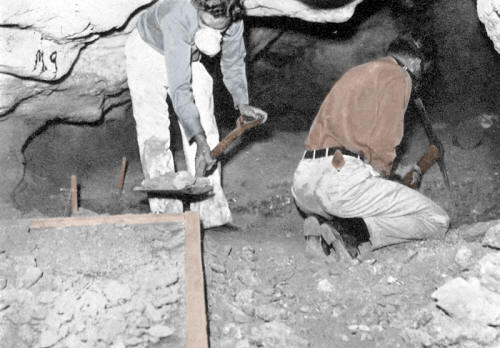
PICTURE FROM
SMITHSONIAN REPORT VOL. 99 NO. 23
SANDIA CAVE
SANDOVAL COUNTY, NEW MEXICO
This
picture shows two archaeologists at work during the excavation of
Sandia Cave sometime in 1939 or 1940. |
|
|
So it would seem
that understanding Sandia is not always very clear and
more-often-than-not rather mysterious. There is no doubt that the
excavator of the site, frank Hibben, lived an extraordinary life and was
very well liked by most of the people he came into contact with. But
it's been said that he could tell a good tale around a camp
fire and he was known for "stretching the truth." As it turns out, the
Sandia Cave report does have many peculiar inconsistencies concerning
just about everything. A number of archaeologists and some of the older
witnesses who were involved in various aspects of the Sandia excavation
have pointed out many problems with just about every part of the
excavation and interpretation of the site. These issues involve the
artifacts, samples used in carbon dating and even the interpretation of
the geology and stratigraphy of the site. |
|
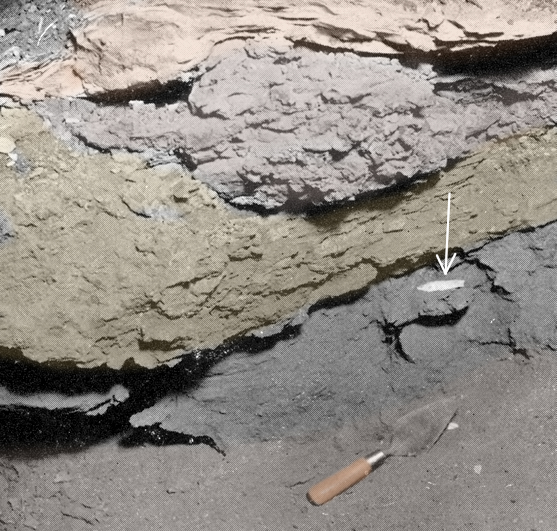
PICTURE FROM
SMITHSONIAN REPORT VOL. 99 NO. 23
SANDIA POINT
IN SITU
SANDIA CAVE
SANDOVAL COUNTY, NEW MEXICO
This picture is described
as a "Sandia point in place at one edge of cave chamber." Nineteen
Sandia points were discovered in Sandia cave. |
|
|
The most important data connected to Sandia Cave has always been the
estimated dates for the lowest occupation level. In 1955 Hibben published in the journal "Science" the
results of carbon dates taken from the remains of extinct animals and
charcoal. The samples returned extraordinarily ancient
dates between 17,000 and 20,000 years ago. But the samples sent to the
lab for dating seem to have been haphazardly done to put it mildly. On
one occasion, an ivory sample sent for testing had a Mousterian tag
attached and Hibben verified that he probably sent the wrong sample.
Another problem involves a reference in the 1955 report about charcoal
samples that were submitted and collected by Kirk Bryan from fire
hearths in the Sandia level. But none of Bryan's intimate associates
ever recall him mentioning anything about sending samples from Sandia
Cave for carbon dating and there was no record at
the carbon dating lab that Bryan ever submitted any samples at all from
the site. Preston writes in his New Yorker article that one of Bryan's
colleagues even wrote to "Science" demanding that Hibben's statement be
retracted. Some time later, Hibben made a statement saying that, "I am
in agreement----that these dates (from Bran's mysterious samples) should
be removed from the record." Yet another problem that concerns Hibben's
most important samples that produced the 20,000 year old date, involves
distinguished professor Lewis Binford who worked at the dating lab at
the time. He believed that the ivory samples that returned the 20,000
year old date were not from Sandia cave either. He bases his evidence on
a mammoth tooth that Hibben sent for dating that was labeled Sandia Cave
but because it was studded with concretions that included pea gravel it
couldn't have come from Sandia Cave. When questioned, Hibben replied
that that he agreed it was probably mislabeled. So it was at this time
that Binford tested the calcium carbonate crust on the ivory samples to
compare the mineral blend with the tooth and found that the ivory was
probably also not from Sandia Cave. Another curious thing is that Hibben
never asked for any of the samples back from the dating lab. Binford
began using the mammoth tooth for a paperweight. |
|
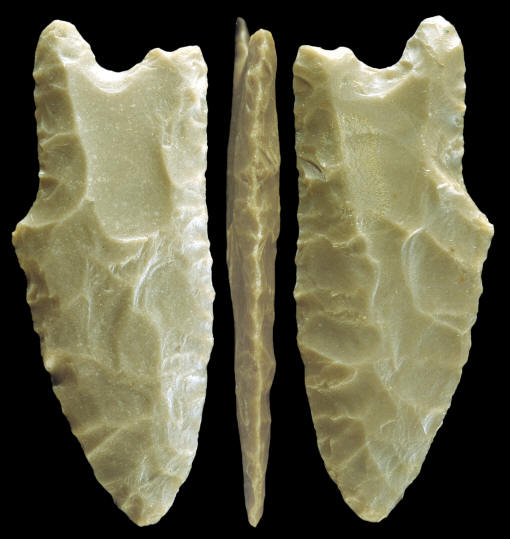
CLICK ON PICTURE FOR LARGER IMAGE
TYPE II SANDIA POINT
SANDIA CAVE
SANDOVAL COUNTY, NEW MEXICO
This is a cast of one of the Sandia
type II points found in Sandia Cave. The cast was made several years
ago by J. Allen Eichenberger. Truncated stem points, like this
example, were described as type II Sandia points. This point represents an ideal concept of what a
missing link between Old and New World spear point design should
look like. It has a single shoulder like Solutrean points from
southwestern Europe and a fluted base that relates to New World
Folsom and Clovis points. This cast measures 2 1/2 inches (6.3 cm)
long. |
|
|
Vance Haynes and George Agogino produced a report in 1986 called
"Geochronology of Sandia Cave," that was published by the Smithsonian
Institution. Haynes said that after the first time he went to the cave
he said to Agogino, "I came out of that cave the first time we were up
there and I said, "George, I don't know what in the hell's going on in
that cave. There's something wrong here." The report states that
Hibben's description of the cave layers are very different than what is
actually there. They determined that it was not a stratigraphically well
defined site and it was covered with a labyrinth of recent and ancient
rodent tunnels. The most important discovery was the dating of the
yellow ochre layer, that was supposed to be located above the Sandia
level. It was found to be at least 300,000 years old. So all the Sandia
material that was reported to be below the yellow ochre must have been
transported there from above. |
|
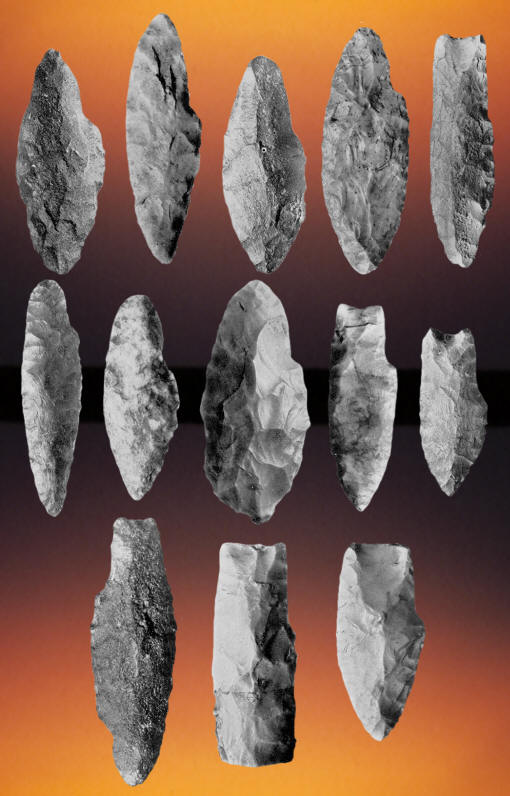
PICTURE FROM
SMITHSONIAN REPORT VOL. 99 NO. 23
CLICK ON PICTURE FOR LARGER IMAGE
SANDIA POINTS
SANDIA CAVE
SANDOVAL COUNTY, NEW MEXICO
These thirteen Sandia points were all found during the excavation of
Sandia Cave. Seven of these points have contracting stems that come
to a rounded point. They are designated as type I Sandia points. The
other six points have truncated bases, some of which are either
slightly concave or almost straight. One or more of these points may
also be described as fluted. The truncated base points are
designated type II Sandia points.
It's interesting that most of the Sandia projectile points are
complete. Most habitation sites would be expected to produce a good
percentage of broken points.
Bruce Bradley examined the Sandia points
several years ago at the University of New Mexico's Maxwell Museum.
He found several oddities concerning various aspects of the points.
The first thing he noticed is that they didn't look as if they all
came from the same location. Some looked fresh as if they were
protected from weathering while others looked like they were laying
on the surface and polished by wind blown sand. Another thing he
noted as strange is they were made by radically different chipping
techniques. Some were made by using fine pressure flaking while
others were very roughly made with percussion flaking. But what is
most interesting is that he observed that, "Two of them clearly
showed modern alteration." One of them had a shoulder that was made
with a grinding wheel and you could see little facets. He also
detected metal marks on another point suggesting that a nail might
have been used to remove some of the flakes. |
|
|
There were nineteen Sandia points reported to have been found below the
300,000 year old yellow ochre layer. It's curious that they were all
transported to that level and none were discovered in any of the above
levels. It's also odd that almost all of the Sandia points are complete
which hardly never occurs on any other type of habitation site. You
would expect to find more broken points. |
|
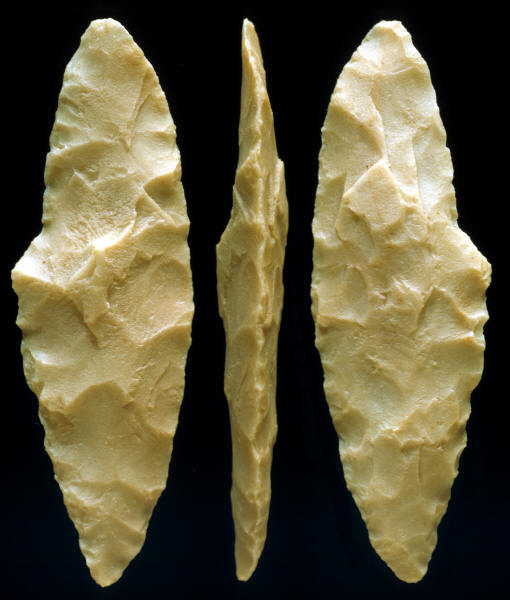
CLICK ON PICTURE FOR LARGER IMAGE
TYPE I SANDIA POINT
SANDIA CAVE
SANDOVAL COUNTY, NEW MEXICO
This is one of the better examples of
a type I Sandia point that was found during the excavation of Sandia
Cave. This cast was made many years ago by J. Allen Eichenberger.
This point has the diagnostic single shoulder and a contracting stem.
It was made with random percussion flaking. This cast measures 3 1/4
inches (8.2 cm) long. |
|
|
Bruce Bradley examined the Sandia points several years ago at the
University of New Mexico's Maxwell Museum. He found several oddities
concerning various aspects of the points. The first thing he noticed is
that they didn't look as if they all came from the same type of
environmental location. Some
looked fresh as if they were protected from weathering while others
looked like they were laying on the surface and polished by wind blown
sand. Another thing he noted as strange is they were made by radically
different chipping techniques. Some were made by using fine pressure
flaking while others were very roughly made with percussion flaking. He
also noted that the points were made from many different types of
stones. But
what is most interesting is that he observed that, "Two of them clearly
showed modern alteration." One of them had a shoulder that was made with
a grinding wheel and you could see little facets. He also detected metal
marks on another point suggesting that a nail might have been used to
remove some of the flakes. |
|
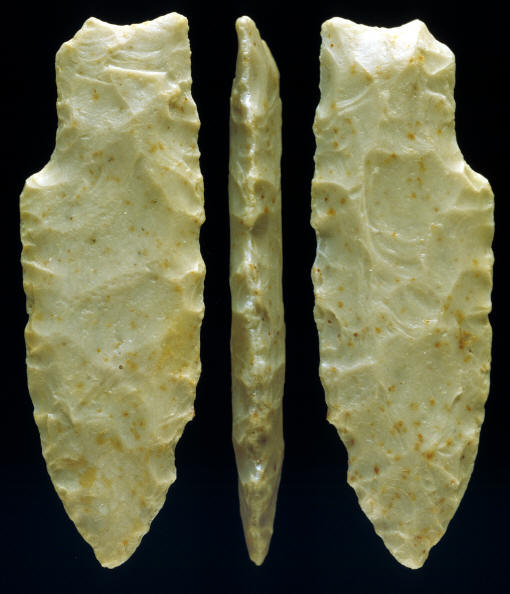
CLICK ON PICTURE FOR LARGER IMAGE
TYPE II SANDIA POINT
SANDIA CAVE
SANDOVAL COUNTY, NEW MEXICO
This type I Sandia point was also
found during the excavation of Sandia Cave in Sandoval County, New
Mexico. The base is slightly damaged on one ear. This cast measures
2 9/16 inches (6.5 cm) long. |
|
|
Most everyone agrees there must be projectile points older than Clovis
since Clovis technology is a New World invention. Bradley suggests that
the Sandia point design is perfect. Especially if you want to make a
connection with Europe. The single shoulder design matches one of the
Solutrean projectile point types from southwestern Europe. Also, if you
add fluting into the design, as some of the Sandia points do have, that
makes a wonderful connection to Folsom and Clovis. It's almost to good
to be true. |
|
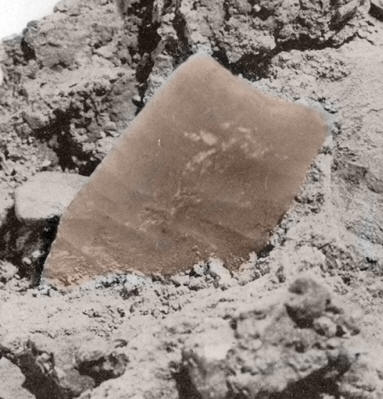
PICTURE FROM
SMITHSONIAN REPORT VOL. 99 NO. 23
FOLSOM POINT IN SITU
SANDIA CAVE
SANDOVAL COUNTY, NEW MEXICO
This picture is described as an "unfluted
Folsom-shaped point embedded in debris from Sandia Cave. The picture
was taken before it was fully excavated. |
|
|
Sandia Cave was a habitation site and yet the people who once lived
there didn't seem to do any of the normal resharpening or repairing
activities that would involve maintaining stone tools. Only six waste flakes were discovered in the upper Folsom level and only
seven waste flakes were found in the Sandia level. It seems odd that
more of this type of lithic debris wasn't found. |
|
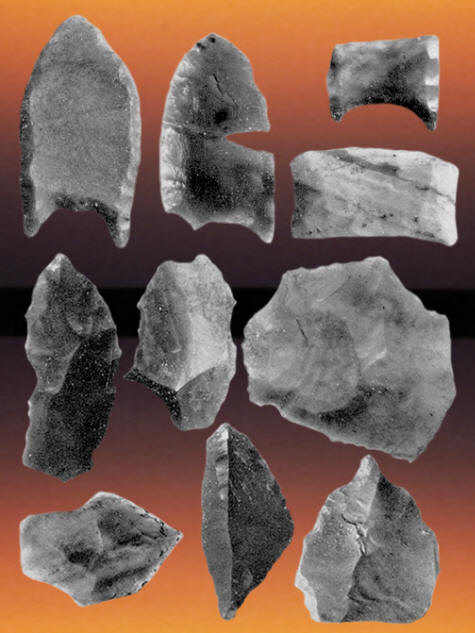
PICTURE FROM
SMITHSONIAN REPORT VOL. 99 NO. 23
FOLSOM POINTS & GRAVERS
SANDIA CAVE
SANDOVAL COUNTY, NEW MEXICO
This picture shows four Folsom points and six
gravers. They are described as "artifacts from Sandia Cave." |
|
|
Also, if the Sandia site was so important, why are eight of the nineteen
Sandia points now missing from the Maxwell Museum. Plus, when Hibben
returned from the war in 1946 it's reported that "many of the specimens
of the Sandia collection (such as) notes, photographs, etc. were (also)
missing or in disarray." Binford also thought it odd that Hibben
never asked for any of the samples back from the dating lab. |
|
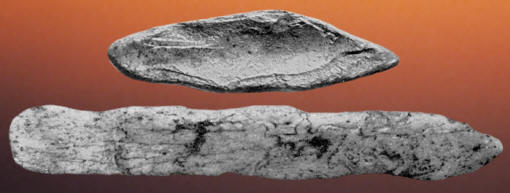
PICTURE FROM
SMITHSONIAN REPORT VOL. 99 NO. 23
BONE & IVORY POINTS
SANDIA CAVE
SANDOVAL COUNTY, NEW MEXICO
Both of these points were found
during the excavation of Sandia Cave. The point at top is simply
described as a bone point. The point at the bottom is described as
an ivory shaft with ground point from Sandia Cave Folsom layer." |
|
|
Binford commented that, "Frank (Hibben) had a reputation in Albuquerque
for-----it would be kind to say-----stretching things." It's
unfortunate, but more than one prominent archaeologist has called the
Sandia Cave site a fraud and the term fibben Hibben has been thrown
about. If Sandia is America's Piltdown hoax it certainly has wasted a
lot of peoples time and seventy years worth of publications about Sandia
must have used a mountain of paper by now. In the very least there is a
good movie in it somewhere. With all the strangeness connected to the
site maybe it should be called the "peculiar site" or the "bazaar-o"
site and let Sandia Cave be put to rest. |
|
"REFERENCES"
1941, Hibben, Frank C., "Evidences Of
Early Occupation In Sandia Cave, New Mexico, And Other Sites In The
Sandia-Manzano Region," Smithsonian
Misc. Collections, Vol. 99, No.23, p. 24.
1965, Bryan, Alan Lyle, "Paleo-American Prehistory," pp. 142-145.
1966, Willey, Gordon R., "An Introduction To American Archaeology,"
pp.40-42.
1978, Jennings, Jesse D., "Ancient Native Americans," p. 332.
1985, Perino, Gregory, "Selected Preforms, Points And Knives Of The
North American Indian," p. 336.
1995, Preston, Douglas, "The Mystery Of Sandia Cave," The New Yorker, p. 66.
1997, Cordell, Linda, "Archaeology Of The Southwest" p. 77.
2006, Huckell, Bruce B. and Judge, W. James, "Paleo-Indian: Plains
And Southwest," Environment, Origins, And Population, Vol. 3,
Smithsonian Institution, p. 149.
|
|
RECENT
LISTINGS HOME
ORDERING |